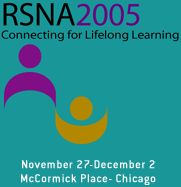
Abstract Archives of the RSNA, 2005
Ashley F. Blurton MD, Presenter: Nothing to Disclose
Adam De La Garza MD, Abstract Co-Author: Nothing to Disclose
Kenneth Ekstrand PhD, Abstract Co-Author: Nothing to Disclose
Thomas McCoy MS, Abstract Co-Author: Nothing to Disclose
Craig Greven MD, Abstract Co-Author: Nothing to Disclose
Kathryn McConnell Greven MD, Abstract Co-Author: Nothing to Disclose
To determine the outcome of uveal melanoma patients treated with Iodine (I-125) plaque brachytherapy utilizing COMS (Collaborative Ocular Melanoma Study) technique and identify factors predictive of tumor outcome. This review was undertaken to compare outcomes from a single non-COMS institution to those of the larger collaborative group.
57 consecutive patients with uveal melanoma treated from 1990-2003 with I-125 plaque brachytherapy were reviewed retrospectively. Demographic, clinical and treatment characteristics were collected and analyzed. Univariate analysis (UVA) of these variables was used to determine prognostic impact. Study endpoints included overall survival (OS), disease free survival (DFS), local tumor control and radiation sequelae. Kaplan Meier estimates of outcomes were obtained. Cox proportional hazards regression was performed using step-wise selection of significant univariate correlates to determine factors predictive of tumor control.
At a median follow up of 3.65 yrs (0.8 - 14), the 5 yr OS was 74.4% (95% CI 60.9 to 87.9) and 5 yr DFS was 69.2% (95% CI 55.2 to 83.2). Overall, there were 5 local failures and 4 distant failures. The 5 yr local control was 90.3% (95% CI 82.2 to 98.5%). At last follow up, radiation retinopathy was detected in 19 patients, optic neuropathy in 4, and radiation cataract in 8 patients. 27 patients had 20/200. 8 patients were secondarily enucleated; 5 for local failure and 3 for treatment related complications. By UVA, the following predicted for improved DFS: younger age (p = 0.017), thinner tumors (p = .022), smaller tumors (p = 0.07), good pretreatment visual acuity (p = .0258), and collar button/dome shaped tumors (p = .0121). The low rate of local recurrence prevented the analysis of predictive factors for local control. On multivariate analysis, younger age (p = 0.0075), smaller tumors (p = 0.0494) and collar button/dome shaped tumors (p = 0.0031) predicted improved DFS.
Excellent local control and visual outcomes are achievable following I-125 plaque brachytherapy for uveal melanomas treated at a non-COMS institution.
Blurton, A,
De La Garza, A,
Ekstrand, K,
McCoy, T,
Greven, C,
Greven, K,
Iodine-125 Plaque Brachytherapy for Uveal Melanomas. Radiological Society of North America 2005 Scientific Assembly and Annual Meeting, November 27 - December 2, 2005 ,Chicago IL.
http://archive.rsna.org/2005/4409965.html

